CRIMEN Y CASTIGO





Revista elaborada por alumnos de quinto año del Instituto San Carlos
Supervisados por el profesor Marcelo Oviedo
Para la materia Administración para la Producción y la Comercialización
Magazine prepared by fifth-year students of the Instituto San Carlos
Supervised by Professor Marcelo Oviedo
For the subject Administration for Production and Marketing
JORJE LUIS BORGES JORJE LUIS BORGES (ENG)
CRIMEN Y CASTIGO CRIME AND PUNSHIMENT
ROCK NACIONAL NATIONAL ROCK
MITOS MYTHS
ANTIGUO EGIPTO ANCIENT EGYPT
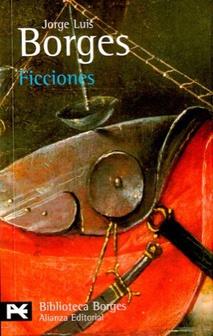
La obra está compuesta por dos partes: “Artificios” y “El jardín de los senderos que se bifurcan” En él, se incluyen cuentos clásicos de la literatura argentina y universal, tales como: “Las ruinas circulares” y “El Sur”


Nació en Buenos Aires, Argentina el 24 de agosto de 1899 Fue uno de los escritores más importantes del siglo XX, conocido por sus cuentos y ensayos de carácter filosófico, místico y metafísico Estudió en la Universidad de Buenos Aires y trabajó como bibliotecario Fue director de la Biblioteca Nacional de Argentina
Borges publicó su primer libro en 1923, "Fervor de Buenos Aires" A partir de entonces, empezó a ser reconocido como escritor. Entre sus obras más "Historia universal de la infamia", "El Aleph" y "Ficciones". En sus cuentos, Borges exploró temas como la identidad, el tiempo, la muerte y la realidad
Borges recibió varios premios y reconocimientos a lo largo de su vida, incluyendo el Premio Cervantes en 1979 Su estilo literario y su perspectiva filosófica influyeron en la literatura y la cultura en todo el mundo Borges murió en Ginebra, Suiza, el 14 de junio de 1986.
Jorge Luis Borges es considerado como una de las figuras clave del género fantástico ya que varios de los libros más vendidos del autor pertenecieron a este género Borges creó un nuevo estilo de literatura y se ocupó de una gran variedad de temas: historia, tiempo, laberintos, sueños, sagas épicas, todo de una manera siempre nueva y sorprendente. El trabajo del escritor argentino se extiende a más de 48 cuentos, poemas y ensayos, y aquí 3 libros destacados que no pueden faltar en tu historial de lecturas
El libro de arena
Es una obra muy bien escrita y articulada El estilo de escritura de Jorge Luis Borges y la forma en que crea un mundo mágico por sí mismo es una razón suficiente para elegir este clásico

Fiction

The work is made up of two parts: “Artifices” and “The garden of forking paths” It includes classic stories from Argentine and universal literature, such as: "Las ruinas circulares" and "El Sur"

He was born in Buenos Aires, Argentina on August 24, 1899 He was one of the most important writers of the 20th century, known for his short stories and essays of a philosophical, mystical, and metaphysical nature. He studied at the University of Buenos Aires and worked as a librarian He was director of the National Library of Argentina.
Borges published his first book in 1923, "Fervor de Buenos Aires". From then on, he began to be recognized as a writer. Among his most works "Universal History of Infamy", "El Aleph" and "Fictions". In his short stories, Borges explored themes such as identity, time, death, and reality
Borges received several awards and recognitions throughout his life, including the Cervantes Prize in 1979 His literary style and philosophical outlook influenced literature and culture throughout the world Borges died in Geneva, Switzerland, on June 14, 1986.
Jorge Luis Borges is considered one of the key figures of the fantastic genre since several of the author's best-selling books belonged to this genre. Borges created a new style of literature and dealt with a wide variety of subjects: history, time, labyrinths, dreams, epic sagas, all in an ever new and surprising way The work of the Argentine writer extends to more than 48 stories, poems and essays, and here are 3 outstanding books that cannot be missing from your reading history
the sand book
It is a very well written and articulated work Jorge Luis Borges' writing style and the way he creates a magical world for himself is reason enough to pick up this classic


El Aleph narra el descubrimiento del personaje Borges de un objeto de objetos en la casa de su antigua amada Beatriz Viterbo.
Esta esfera de dos a tres centímetros de diámetro en el sótano de una vieja casa en la calle Garay, Buenos Aires, es el espejo y centro de todas las cosas, en el cual todo confluye y se refleja, a la vez y sin sobreposición. La cantidad de alusiones es innumerable; bien podría ser el propio universo, como dice el narrador, pero también alude a la biblioteca, y, se dice, de forma irónica al Canto general de Neruda Además recuerda, tanto en Carlos Argentino Daneri y en Beatriz Viterbo como en el descenso al sótano, a la Divina Comedia de Dante
El Aleph es uno de los libros de cuentos más representativos del escritor argentino Jorge Luis Borges Publicado en 1949, fue reeditado por el autor en 1974 Sus textos remiten a una infinidad de fuentes y bibliografías en torno a las cuales se articulan mitos y metáforas de la tradición literaria universal Esta obra marca un punto de inflexión respecto al estilo que destilaba su colección anterior de cuentos, Ficciones; aún manteniendo su estilo sobrio y perfeccionista, el escritor aborda aquí otra serie de eventos u objetos inverosímiles enmarcados en un ambiente realista, lo que contribuye a resaltar su carácter fantástico

23 de octubre de 1957, El Aleph fue galardonado con el primer premio en la categoría "Obras de Imaginación en Prosa",en el marco de los Premios Nacionales de la Secretaría de Cultura de la Nación.
Borges describe el Aleph como “ una pequeña esfera tornasolada, de casi intolerable fulgor”, cuyo diámetro sería “de dos o tres centímetros, pero el espacio cósmico estaba allí, sin disminución de tamaño”
Es el punto mítico del universo donde todos los actos, todos los tiempos (presente, pasado y futuro), ocupan “el mismo punto, sin superposición y sin transparencia”
El Aleph,” א « es la primera consonante del alfabeto hebreo, posee diversos significados, simboliza el poder transformador, poder cultural, energía creadora o universal, poder de vida, canal de la creación, también el principio y el fin dada su condición de atemporalidad

The Aleph narrates the discovery of the character Borges of an object of objects in the house of his former lover Beatriz Viterbo. This sphere of two to three centimeters in diameter in the basement of an old house on Garay street, Buenos Aires, is the mirror and center of all things, in which everything converges and is reflected, at the same time and without overlapping.
The number of allusions is innumerable; It could well be the universe itself, as the narrator says, but it also alludes to the library, and, it is said, ironically to Neruda's Canto general He also recalls, both in Carlos Argentino Daneri and in Beatriz Viterbo as in the descent into the basement, Dante's Divine Comedy.
The Aleph is one of the most representative storybooks of the Argentine writer Jorge Luis Borges Published in 1949, it was republished by the author in 1974 His texts refer to an infinite number of sources and bibliographies around which myths and metaphors of the universal literary tradition are articulated This work marks a turning point with respect to the style exuded by his previous collection of short stories, Ficciones; Still maintaining his sober and perfectionist style, the writer addresses here another series of implausible events or objects framed in a realistic environment, which helps to highlight its fantastic character

October 23, 1957, El Aleph was awarded the first prize in the category "Imagination Works in Prose", within the framework of the National Awards of the Ministry of Culture of the Nation
Borges describes the Aleph as “ a small iridescent sphere, of almost intolerable brilliance”, whose diameter would be “two or three centimeters, but the cosmic space was there, without diminishing its size”. It is the mythical point of the universe where all acts, all times (present, past and future), occupy "the same point, without overlap and without transparency"
The Aleph," א " is the first consonant of the Hebrew alphabet, it has various meanings, it symbolizes transformative power, cultural power, creative or universal energy, power of life, channel of creation, also the beginning and the end given its condition of timelessness.

En 1840, en un pueblo llamado La Majadita, vivía Deolinda Correa junto a su marido y el pequeño hijo de ambos

Un día irrumpieron las montoneras, reclutando soldados para la guerra Se llevan a su marido por la fuerza Deolinda, joven y bella, queda sola y desprotegida Es acechada por un comisario y escapa siguiendo los rastros de su amado y llevando su bebé en brazos Después de un largo caminar por el desierto, cae exhausta y se recuesta bajo un árbol Allí muere deshidratada
Unos arrieros encuentran a Deolinda tendida junto a su bebé, que milagrosamente sigue vivo, amamantándose de su difunta madre. Luego entierran a Deolinda y se llevan al pequeño.
Unos años después, en medio del desierto, un arriero pierde todo su ganado en una tormenta. Desesperado se arrodilla en la tumba de "La Deolinda" y le pide ayuda. Al día siguiente sus quinientas cabezas de ganado aparecen sanas y salvas.
Así, la Difunta Correa empieza su largo camino en el mundo de los necesitados, convirtiéndose en la leyenda del desierto cuyano.
Antonio Gil fue un gaucho rural, que tuvo un romance con la hija de un comandante local. Esto le hizo ganar el odio de los hermanos de la hija del comandante, y del jefe de la policía local, quien había cortejado a esa misma mujer. Como consecuencia del peligro que esto implicaba, Gil dejó el área y se alistó para pelear en la Guerra de la Triple Alianza (18641870).
¿Qué son las leyendas?
La leyenda es un tipo de narración se refiere a la relación del hombre con lo sobrenatural y sus temas pueden ser religiosos o profanos Pueden presentarse elementos sobrenaturales como milagros, criaturas feéricas o de ultratumba etc Y estos sucesos se presentan como reales y forman parte de la visión del mundo propia o de la comunidad en la que se originan
Luego de regresar, fue reclutado por el Partido Autonomista para pelear en la guerra civil correntina contra el opositor Partido Liberal, pero él desertó.Dado que la deserción era delito, fue capturado, colgado de su pie en un árbol de espinillo, y degollado. Antes de ser ejecutado, Gil le dijo a su verdugo que debería rezar en nombre de Gil por la vida de su hijo, quien estaba muy enfermo; al principio, el verdugo desconfió de él, pero cuando regresó a su hogar, el verdugo encontró a su hijo casi agonizando;
desesperado, el verdugo le rezó a Gil y su hijo sanó milagrosamente. Él le dio al cuerpo de Gil un entierro apropiado, y las personas que se enteraron del milagro construyeron un santuario, que creció hasta hoy

"El Gauchito Gil"
EIn 1840, in a town called La Majadita, Deolinda Correa lived with her husband and their little son Deolinda Correa lived with her husband and their little son
One day the montoneras broke in, recruiting soldiers for the war. They take her husband by force.
Deolinda, young and beautiful, is left alone and unprotected. She is stalked by a commissioner and escapes from her by following the tracks of her lover and carrying her baby in her arms.
After a long walk through the desert, she falls exhausted and lies down under a tree. There she dies dehydratededda
Some muleteers find Deolinda lying next to her baby, who miraculously is still alive, nursing from her deceased mother. Then they bury Deolinda and take the little one away.

A few years later, in the middle of the desert, a muleteer loses all his cattle in a storm. Desperate, he kneels at the grave of "La Deolinda" and asks for her help. The next day his five hundred head of cattle turn up safe and sound. Thus the deceased Correa begins her long journey in the world of the needy, becoming the legend of the Cuyo desert.
Antonio Gil was a rural gaucho, who had an affair with the daughter of a local commander. This earned him the hatred of the commander's daughter's brothers, and the local police chief, who had courted that very woman. As a consequence of the danger that this implied, Gil left the area and enlisted to fight in the War of the Triple Alliance (1864-1870).

The legend is a type of narrative refers to the relationship of man with the supernatural and its themes can be religious or profane Supernatural elements such as miracles, fairy creatures or from beyond the grave, etc may appear And these events are presented as real and are part of their own worldview or of the community in which they originate
After returning, he was recruited by the Autonomist Party to fight in the Corrientes civil war against the opposition Liberal Party, but he deserted. Since desertion was a crime, he was captured, hung by his foot on a thorn tree, and beheaded. Before being executed, Gil told his executioner that he should pray on Gil's behalf for the life of his son, who was very ill; At first, the executioner mistrusted him, but when he returned home, the executioner found his son nearly dying.
Desperate, the executioner prayed to Gil and his son was miraculously healed. He gave Gil's body a proper burial, and the people who heard of the miracle built a shrine, which grew until today
Crimen y castigo es una novela de carácter psicológico escrita por el autor ruso Fiódor Dostoyevski. Fue publicada por primera vez, por entregas, en la revista El mensajero ruso, entre 1866 y 1867, en doce partes, y publicada después como libro. Junto con Guerra y paz de León Tolstói, se considera una de las novelas más influyentes e internacionales de la literatura rusa.

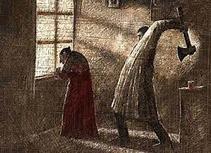
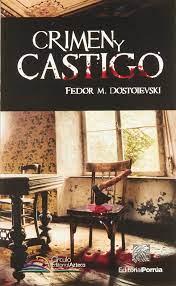
El protagonista de esta obra, que apenas sobrevive, debe abandonar sus estudios, situación que lo resiente y por lo cual decide cometer un crimen –alevoso y premeditadocontra una vieja usurera que se aprovechaba de la miseria de la gente Sin embargo, tomar justicia por su propia mano no resulta tan sencillo como él lo pensó, pues a esta decisión le sucede la culpa
El dilema del libre albedrío es uno de los temas centrales en esta novela, que se desarrolla en un entorno de pobreza extrema que lleva a los personajes a cometer actos indignos –como la prostitución, el robo o el asesinato- para subsistir Dostoievski plantea que los actos del individuo no pueden separarse de las normas sociales, por eso el arrepentimiento del protagonista homicida
Asimismo, los diálogos mantenidos entre el protagonista, Raskólnikov, y el inspector de policía son considerados por algunos autores, como el prestigioso literato Stefan Zweig, una de las cimas de la literatura universal.

Crimen y castigo explora zonas oscuras de la psique humana, y logra conmover al lector porque los temas que aborda (la injusticia social, la necesidad extrema, el problema de decidir entre el bien o el mal, las adicciones que enturbian la mente de los individuos, etc )
Una obra de arte sobre cómo reacciona un hombre ante sus actos erróneos El mensaje de fondo es el siguiente: "después del crimen viene el castigo" y la única manera de recuperar la paz de espíritu es el arrepentimiento, asumir la verdad, y la conversión del corazón a través del amor Describe cómo es de complicada la personalidad de un ser hundido en la degradación moral, pero a la vez interpelado continuamente por su conciencia, por las personas que le rodean
Fiódor Mijáilovich Dostoyevski fue uno de los principales escritores de la Rusia zarista, cuya literatura explora la psicología humana en el complejo contexto político, social y espiritual de la sociedad rusa de la segunda mitad del siglo xix
Nació un 11 de noviembre de 1821, en la capital de Rusia, Moscú Falleció un 9 de febrero de 1881 en la localidad de San Petersburgo, Rusia
Crime and Punishment is a psychological novel written by the Russian author Fyodor Dostoyevsky. It was published for the first time, in installments, in the magazine The Russian Messenger, between 1866 and 1867, in twelve parts, and later published as a book. Along with Leo Tolstoy's War and Peace, it is considered one of the most influential and international novels in Russian literature.
EThe protagonist of this work, who barely survives, must abandon his studies, a situation that resents him and for which he decides to commit a crime - treacherous and premeditated - against an old usurer who took advantage of people's misery. However, taking justice into his own hand is not as easy as he thought, because this decision is followed by guilt
The dilemma of free will is one of the central themes in this novel, which takes place in an environment of extreme poverty that leads the characters to commit unworthy actssuch as prostitution, robbery or murder- in order to survive Dostoevsky argues that the acts of the individual cannot be separated from social norms, hence the repentance of the homicidal protagonist


Likewise, the dialogues between the protagonist, Raskolnikov, and the police inspector are considered by some authors, such as the prestigious writer Stefan Zweig, one of the tops of universal literature.
Crime and Punishment explores areas of the human psyche, and manages to move the reader because the themes it addresses are dark (social injustice, extreme need, the problem of deciding between good or evil, addictions that cloud the minds of individuals , etc )

A work of art about how a man reacts to his wrong acts The background message is the following: "after the crime comes the punishment" and the only way to recover peace of mind is repentance, assuming the truth, and the conversion of the heart through love It describes how complicated the personality of a being sunk in moral degradation is, but at the same time continually questioned by his conscience, by the people around him
Fyodor Mikhailovich Dostoyevsky was one of the leading writers of tsarist Russia, whose literature explores human psychology in the complex political, social, and spiritual context of Russian society in the second half of the 19th century.
He was born on November 11, 1821, in the Russian capital, Moscow. He died on February 9, 1881 in the town of Saint Petersburg, Russia.


CULTURALES 28 DE ABRIL DE 2023
El Rock Argentino es un género musical enérgico y diverso que ha desempeñado un papel importante en la cultura y la historia de Argentina, con artistas que han dejado una huella perdurable en la música y la sociedad del país Se caracteriza por su energía y rebeldía, y ha sido utilizado como una forma de expresión de protesta social y política Muchas de las bandas y artistas más emblemáticos del género han abordado temas como la injusticia, la desigualdad y la represión en sus letras, convirtiéndose en voces influyentes en la sociedad argentina
El Rock Argentino se originó en la década de 1960 Si bien es difícil establecer una fecha exacta, este período marca el surgimiento de varias bandas y artistas que sentaron las bases del género en Argentina Entre los pioneros del Rock Argentino se encuentran Los Gatos, liderados por Litto Nebbia, quienes lanzaron su álbum debut en 1967, y Almendra, liderados por Luis Alberto Spinetta, quienes lanzaron su álbum homónimo en 1969 Estas bandas fueron influencias clave en el desarrollo del Rock Argentino y sentaron las bases para el surgimiento de otras bandas icónicas en las décadas siguientes
El rock argentino representa un compendio de experiencias que exceden lo meramente musical y lírico Fundamentalmente, el rock producido en el país produce y provoca enlaces desde el terreno de la cultura, activando identidades y cosmovisiones para lidiar contra los convencionalismos
CULTURAL APRIL 28, 2023
Argentine Rock is an energetic and diverse musical genre that has played an important role in the culture and history of Argentina, with artists who have left a lasting mark on the country's music and society It is characterized by its energy and rebelliousness, and has been used as a form of expression of social and political protest Many of the most emblematic bands and artists of the genre have addressed issues such as injustice, inequality and repression in their lyrics, becoming influential voices in Argentine society

Argentine Rock originated in the 1960s Although it is difficult to establish an exact date, this period marks the emergence of several bands and artists who laid the foundations of the genre in Argentina Among the pioneers of Argentine Rock are Los Gatos, led by Litto Nebbia, who released their debut album in 1967, and Almendra, led by Luis Alberto Spinetta, who released their self-titled album in 1969 These bands were key influences in the development of Argentine Rock Argentine Rock and laid the foundations for the emergence of other iconic bands in the following decades
Argentine rock represents a compendium of experiences that exceed the merely musical and lyrical Fundamentally, the rock produced in the country produces and causes links from the field of culture, activating identities and worldviews to fight against conventions
CULTURAL APRIL 28, 2023
Las características del Rock Nacional son marcar acentuación rítmica; Uso de efectos de distorsión; Uso frecuente de síncopa; Canciones estructuradas en verso/estribillo, intercaladas por solos o improvisaciones
DONA GALLARDO

Hoy en día el rock argentino es destacado y reconocido en toda Latinoamérica por la popularidad de las bandas y los artistas que alcanzaron récords en ventas de álbumes y en asistencias a recitales.

El Cosquín Rock es un festival de música que se lleva a cabo anualmente, desde 2001, en la provincia de Córdoba (Argentina), con una duración promedio de 2 a 3 días
En las entrevistas del estudio de Tripathy y Chaudhari, en 2021, la mayoría de los participantes que eran amantes del rock expresaron que la música rock podía amplificar su emociones, mejorar su estado de ánimo e inducir una inmensa energía
CULTURAL APRIL 28, 2023
The characteristics of the National Rock are to mark rhythmic accentuation; Use of distortion effects; Frequent use of syncopation; Songs structured in verse/chorus, interspersed by solos or improvisations
EL COSQUÍN ROCK IS A MUSIC FESTIVAL THAT TAKES PLACE ANNUALLY, SINCE 2001, IN THE PROVINCE OF CÓRDOBA (ARGENTINA), WITH AN AVERAGE DURATION OF 2 TO 3 DAYS
DONA GALLARDO


In Tripathy and Chaudhari's 2021 study interviews, the majority of participants who were rock lovers expressed that rock music could amplify their emotions, improve their mood, and induce immense energy
Today Argentine rock is prominent and recognized throughout Latin America for the popularity of bands and artists who reached records in album sales and concert attendance.


En 2007 la revista “Rolling Stone” situó entre los diez mejores discos del rock argentino dos de sus álbumes: “Artaud” (1973), grabado con el grupo “Pescado Rabioso”, y “Almendra” (1969), el primero de la banda que llevaba el mismo nombre En las letras de Spinetta se percibía la influencia de Jean Paul Sartre, Michel Foucault y el propio Antonin Artaud. Murió en 2012
Grabó cuarenta y siete discos en cuarenta y ocho años: desde 1969, cuando junto a Nito Mestre conformó “Sui Generis” hasta el álbum “Random”, última obra como solista A los 12 años obtuvo el título de profesor de música Entre 1977 y 1982 integró la banda “Serú Girán” De su etapa como solista se destacan “Yendo de la cama al living” (1982), “Clics modernos” (1983) y “Piano Bar” (1984)
A mediados de los años ochenta Cerati, al frente de “Soda Stereo”, banda que integraba junto con Zeta Bossio y Charly Alberti, llevó el rock argentino a toda Latinoamérica y a España Desde la admiración que tenía por García y Spinetta se convirtió en el único músico capaz de disputarles la categoría de máximos referentes Ellos, a su vez, lo elogiaban Para los críticos musicales, fue el más grande cantante del género y uno de los mejores guitarristas. Falleció en 2014.
 Charly Garcia
Gustavo Cerati
Luis Alberto Spinetta
Charly Garcia
Gustavo Cerati
Luis Alberto Spinetta
In 2007, “Rolling Stone” magazine placed two of his albums among the ten best Argentine rock albums: “Artaud” (1973), recorded with the group “Pescado Rabioso”, and “Almendra” (1969), the first of the band with the same name In Spinetta's lyrics the influence of Jean Paul Sartre, Michel Foucault and Antonin Artaud himself was perceived. He died in 2012.


He recorded forty-seven albums in fortyeight years: from 1969, when he formed “Sui Generis” together with Nito Mestre, to the album “Random”, his last work as a soloist At the age of 12 he obtained the title of music teacher Between 1977 and 1982 he was a member of the band “Serú Girán”. From his stage as a soloist, "Yendo de la cama al living" (1982), "Clics modernos" (1983) and "Piano Bar" (1984) stand out
In the mid-eighties Cerati, at the helm of "Soda Stereo", a band that he was part of along with Zeta Bossio and Charly Alberti, brought Argentine rock to all of Latin America and Spain From the admiration he had for García and Spinetta, he became the only musician capable of disputing them for the category of maximum references They, in turn, praised him For music critics, he was the greatest singer of the genre and one of the best guitarists. He passed away in 2014.
 Charly Garcia
Gustavo Cerati
Luis Alberto Spinetta
Charly Garcia
Gustavo Cerati
Luis Alberto Spinetta
NÚMERO 10 ⎮ 14 DE MARZO DE 2023
Es considerada una de las grandes voces del rock nacional argentino por su potencia y su amplio registro vocal. Comenzó su carrera cantando canciones de blues en el grupo “Alter Ego” entre 1975 y 1977 Acompañó a Lito Nebbia en el “Festival Pan Caliente” de 1982 y, ese mismo año, acompañó a Sandra Mihanovich en “Es la vida que me alcanza” Más tarde lanzó su primer disco: “Me vuelvo cada día más loca” (1982) En 1985 abandonó el blues y formó una banda de punk producida por Charly García, de la que sobresale el tema “Seré judía”. Más tarde, armó espectáculos con Sandra Mihanovich y Ludovica Squirru


A los 21 años se sumó como pianista a la banda “Los Abuelos de la Nada”, un grupo que había nacido de la mano de Miguel Abuelo, su cantante. En poco tiempo sus canciones, como “Sin gamulán” y “Mil horas”, se convirtieron en éxitos y Charly García le produjo su primer álbum llamado “Hotel Calamaro” (1984). Llevó su carrera como solista a España, donde luego, en 1990, formó la banda “Los Rodríguez” junto a Ariel Rot y los españoles Germán Vilella y Julián Infante. La banda se separó en 1996 después de un éxito masivo con tres álbumes de estudio Su influencia continúa hoy en ambos lados del Atlántico

Considered one of the great voices of Argentine national rock for his power and wide vocal range. He began his career singing blues songs in the group “Alter Ego” between 1975 and 1977 He accompanied Lito Nebbia at the “Pan Caliente Festival” in 1982 and, that same year, he accompanied Sandra Mihanovich in “Es la vida que me reaches ” Later she released her first album: "I get crazier every day" (1982). In 1985 he abandoned blues and formed a punk band produced by Charly García, of which the song “I will be Jewish” stands out. Later, he put together shows with Sandra Mihanovich and Ludovica Squirru


At the age of 21, he joined the band “Los Abuelos de la Nada” as a pianist, a group that had been born by the hand of Miguel Abuelo, its singer. In a short time his songs, such as "Sin gamulán" and "Mil horas", became hits and Charly García produced his first album called "Hotel Calamaro" (1984). He took his solo career to Spain, where later, in 1990, he formed the band "Los Rodríguez" together with Ariel Rot and the Spaniards Germán Vilella and Julián Infante. The band broke up in 1996 after massive success with three studio albums. His influence continues today on both sides of the Atlantic

Los mitos son narraciones que expresan las ideas ancestrales de un pueblo acerca del mundo en el cual vive. Surgieron para que dichos pueblos le puedan dar una respuesta a cuestiones que les resultaban inexplicables. Los mitos son narraciones que expresan las ideas ancestrales de un pueblo acerca del mundo en el cual vive. Surgieron para que dichos pueblos le puedan dar una respuesta a cuestiones que les resultaban inexplicables.
Los mitos surgieron en la época de la humanidad primigenia como una respuesta y sentido a todas aquellas incógnitas que el ser humano tenía sobre el origen de la vida, de los seres, de nuestras conductas, de las cosas, de la Tierra como la conocemos y del universo.







Myths are narratives that express the ancestral ideas of a people about the world in which they live. They arose so that these peoples could give an answer to questions that were inexplicable to them Myths are narratives that express the ancestral ideas of a people about the world in which they live. They arose so that these peoples could give an answer to questions that were inexplicable to them.
The myths arose in the time of primitive humanity as a response and meaning to all those unknowns that the human being had about the origin of life, of beings, of our behaviors, of things, of the Earth as we know it and of the universe.

¿Para que sirven los mitos?
El mito tiene una doble función social y psíquica que sirven a diferentes propósitos, por un lado permite los procesos de socialización y aculturación a partir de la moraleja y el temor al castigo por la infracción, y por otro facilita la realización proyectiva de deseos inconscientes proscritos
Por ejemplo el mito de Eco y Narciso que explicaba la creación de ambos.
Estas leyendas suelen formar ciclos de carácter temporal, territorial o familiar. Las leyendas suelen explicar fenómenos extraordinarios y dignos de ser recordados, considerándose que, mientras el mito pertenece al "saber sagrado" del grupo, la leyenda pertenece al "saber histórico" y conforma la memoria colectiva del grupo Tanto en mito como la leyenda forman parte de la tradición oral de los pueblos. Se trata de narraciones que sirven para contar o explicar determinados episodios de generación en generación, por lo que su valor cultural siempre es destacado Sin embargo existe una diferencia entre mito y leyenda.
La leyenda es un relato folclórico creado con elementos de ficción que puede tener base en algún suceso histórico, pero que con el paso de los años ha sido enriquecido con características fantasiosas Suele servir para explicar algún acontecimiento histórico o propio de una comunidad.
Un elemento característico de la leyenda es que con el tiempo se va alimentando del boca a boca, es por esto que una misma leyenda puede ser diferente entre una población y otra, ya que se adapta a las circunstancias de cada comunidad La leyenda suele tener también un carácter literario, por lo que es posible adquirir libros con este tipo de historias.
Un buen ejemplo bastante universal es la leyenda del caballo de Troya
Por su parte el mito es una narración también de carácter maravilloso, protagonizada normalmente por personajes sobrenaturales y heroicos, pero que en lugar de pretender narrar un suceso histórico buscan explicar el origen del mundo, los fenómenos naturales o determinados aspectos religiosos vinculados a esa comunidad o civilización
La mitología es la encargada de agrupar todos los mitos de una determinada comunidad o civilización. Entre las mitologías más famosas encontramos la griega, la romana o la escandinava

Entre los mitos más populares podemos mencionar la caja de Pandora perteneciente a la mitología griega, el mito de Excalibur la famosa espada del Rey Arturo o el mito de la creación del mundo del Popol Vuh que corresponde a los mayas.

Para Vico el mito era una verdad histórica que poseía sus propias características y expresaba ciertas formas habituales y básicas de la vida humana
The myth has a double social and psychic function that serve different purposes, on the one hand it allows the processes of socialization and acculturation based on the moral and the fear of punishment for the infraction, and on the other it facilitates the projective realization of proscribed unconscious desires. For example, the myth of Eco and Narciso that explained the creation of both.

Relationship between myths and legends

Relationship between myths and legends These legends usually form cycles of a temporary, territorial or family nature The legends usually explain extraordinary phenomena and worth remembering, considering that while the myth belongs to the "sacred knowledge" of the group, the legend belongs to the "historical knowledge" and forms the collective memory of the group Both in myth and legend they are part of the oral tradition of the peoples. These are narratives that serve to tell or explain certain episodes from generation to generation, so their cultural value is always highlighted. However, there is a difference between myth and legend. The legend is a folkloric story created with elements of fiction that may be based on some historical event, but that over the years has been enriched with fanciful characteristics. It is usually used to explain some historical event or one typical of a community
A characteristic element of the legend is that over time it is fed by word of mouth, which is why the same legend can be different from one population to another, since it adapts to the circumstances of each community. The legend usually also has a literary nature, so it is possible to acquire books with this type of story A good, fairly universal example is the legend of the Trojan horse. For its part, the myth is also a narrative of a marvelous nature, usually starring supernatural and heroic characters, but instead of trying to narrate a historical event, they seek to explain the origin of the world, natural phenomena or certain religious aspects linked to that community or civilization Mythology is in charge of grouping all the myths of a certain community or civilization. Among the most famous mythologies we find the Greek, the Roman or the Scandinavian Among the most popular myths we can mention the Pandora's box belonging to Greek mythology, the myth of Excalibur the famous sword of King Arthur or the myth of the creation of the world of the Popol Vuh that corresponds to the Mayans.
For Vico, the myth was a historical truth that had its own characteristics and expressed certain habitual and basic forms of human life.
El antiguo Egipto o Egipto antiguo fue una civilización de la Antigüedad que se originó a lo largo del cauce medio y bajo del río Nilo y cuya historia abarca más de tres milenios Es considerado una de las cunas de la civilización El nombre original del país, especialmente durante el Imperio Antiguo, fue Kemet (Km t), ‘tierra negra ’ , por el color del limo fertilizante que cubría durante la regular inundación anual el valle que se encuentra a orillas del río Nilo

Egipto se encuentra en el extremo nordeste de África y forma parte del occidente de Asia

Limita al norte con el mar Mediterráneo, al este con el mar Rojo e Israel, al sur con Sudán y al con Libia.
Se caracteriza por un clima desértico mitigado por la influencia del río Nilo y sus mares limítrofes.
Es uno de los países con más población de África, cuya mayor parte se asienta en las riberas del río Nilo Egipto es famoso por su civilización antigua y sus monumentos, como las pirámides y la gran esfinge
La mitología egipcia comprende el estudio de creencias sustentadas en la religión del Antiguo Egipto desde la época predinástica hasta la imposición del cristianismo, cuando sus prácticas
fueron prohibidas en tiempos de Justiniano I, en el año 535 Su desarrollo e influencia perduraron más de tres mil años, variando lógicamente a través del tiempo; por lo tanto, un artículo o incluso un libro, solo puede resumir la multitud de entidades y temas de este sistema complejo de creencias. La variada iconografía egipcia es muy diferente de la griega o romana: en la mitología egipcia muchas deidades son representadas con cuerpo humano, y cabezas de otros animales
LDurante la época predinástica, divinizaron aquellos fenómenos naturales que les desconcertaban, o infundían temor, de los que no conocían la razón de su proceder; asociaron estas divinidades con las características de ciertos animales, y los representaron con forma humana aunque conservando rasgos zoomorfos: el halcón en el dios Horus, "el elevado", dios del cielo; el perro egipcio, o chacal del desierto, "el guardián de las necrópolis", se convierte en un dios protector, Anubis; el cocodrilo del Nilo, un peligro constante, en un dios temido, venerado en la región de El Fayum, etc Además les atribuyeron
conceptos humanos, como la relación familiar, por lo que se formaron tríadas compuestas por un dios, su esposa y su hijo, y también pasiones humanas por lo que se les rendía culto dando ofrendas en los templos a cambio de favores solicitados, o recibidos. A pesar de la agrupación de los pueblos egipcios en las "Dos Tierras": el Alto y Bajo Egipto, cada uno de los nomos (provincias) mantuvo sus deidades protectoras, lo que significaba la veneración a decenas de dioses, que adquirían mayor o menor relevancia según la importancia que tuviese cada ciudad: en Heliópolis se adoraba a Ra, en Tebas a Amón, en Menfis a Ptah y Hator. Los sacerdotes de los templos principales comenzaron a organizar esta multitud de dioses y a explicar sus relaciones, la creación del mundo, las crecidas del Nilo, etc , ideando y sistematizando las creencias en las denominadas teología Heliopolitana, Tebana, etc , reflejadas en los Textos de las Pirámides, o el Libro de los Muertos, a los que siguió la redacción de otros similares Geb, en la zona inferior, con Shu y Nut Su visión está basada en su propio país, tierra fértil junto a un río y con un desierto alrededor Por lo tanto el mundo para ellos se dividía en tres regiones: El Cielo, Nun, morada de los dioses, cuya diosa celeste Nut, "La grande que parió a los dioses", era representada como una mujer con el cuerpo arqueado cubriendo toda la Tierra La Tierra, morada de los hombres, la Casa de Geb, el dios creador, representado como un hombre tumbado bajo Nut El Más Allá, o Duat, el reino de los muertos, donde gobernó Osiris, y posteriormente Horus, espacio recorrido en su barca solar por Ra durante la noche, y por donde transitaban los espíritus de los difuntos sorteando los peligros, cuyo dios es Socar
Ancient Egypt or ancient Egypt was an ancient civilization that originated along the middle and lower reaches of the Nile River and whose history spans more than three millennia It is considered one of the cradles of civilization The original name of the country, especially during the Old Kingdom, was Kemet (Km.t), 'black earth', from the color of the fertilizing silt that covered during the regular annual flooding the valley that lies on the banks of the Nile River

Egypt is located in the northeast corner of Africa and is part of western Asia. It limits to the north with the Mediterranean Sea, to the east with the Red Sea and Israel, to the south with Sudan and to the Libya.
¿What characteristics does your geographical environment have?
It is characterized by a desert climate mitigated by the influence of the Nile River and its bordering seas.
It is one of the most populous countries in Africa, most of which settles on the banks of the Nile River Egypt is famous for its ancient civilization and its monuments, such as the pyramids and the great sphinx

Egyptian mythology includes the study of beliefs supported by the religion of Ancient Egypt from predynastic times to the imposition of Christianity, when its practices
they were prohibited in the time of Justinian I, in the year 535 Their development and influence lasted more than three thousand years, varying logically through time; therefore, an article or even a book can only summarize the multitude of entities and themes in this complex belief system The varied Egyptian iconography is very different from the Greek or Roman: in Egyptian mythology many deities are represented with a human body, and heads of other animals
During the predynastic era, they deified those natural phenomena that puzzled them, or instilled fear, of those who did not know the reason for their behavior; They associated these divinities with the characteristics of certain animals, and represented them in a human form although preserving zoomorphic features: the falcon in the god Horus, "the elevated one " , god of the sky; the Egyptian dog, or jackal of the desert, "the guardian of the necropolis", becomes a protective god, Anubis; the Nile crocodile, a constant danger, a feared god, venerated in the region of El Fayum, etc. They also attributed
human concepts, such as the family relationship, for which triads were formed composed of a god, his wife and his son, and also human passions for which they were worshiped by giving offerings in the temples in exchange for favors requested, or received. Despite the grouping of the Egyptian peoples into the "Two Lands": Upper and Lower Egypt, each one of the nomes (provinces) maintained their protective deities, which meant the veneration of dozens of gods, which acquired more or less relevance according to the importance of each city: in Heliopolis Ra was worshiped, in Thebes Ammon, in Memphis Ptah and Hathor The priests of the main temples began to organize this multitude of gods and explain their relationships, the creation of the world, the flooding of the Nile, etc , devising and systematizing the beliefs in the socalled Heliopolitan, Theban, etc theology, reflected in the Texts of the Pyramids, or the Book of the Dead, which were followed by the writing of other similar ones Geb, in the lower zone, with Shu and Nut His vision is based on his own country, fertile land next to a river and with a desert around it Therefore, the world for them was divided into three regions: Heaven, Nun, home of the gods, whose celestial goddess Nut, "The great one who gave birth to the gods", was represented as a woman with an arched body covering the entire Land The Earth, home of men, the House of Geb, the creator god, represented as a man lying under Nut The Beyond, or Duat, the kingdom of the dead, where Osiris ruled, and later Horus, a space traveled by Ra in his solar boat during the night, and where the spirits of the deceased traveled avoiding dangers, whose god is Socar
Genesis
Mientras los líderes de los diversos grupos ganaban y perdían influencia, las creencias dominantes se transformaban, combinaban y sincretizaban Ra y Atón se convirtieron en AtónRa, con las características de Ra como dominantes, y posteriormente Ra fue asimilado a su vez por Horus, como Ra-Horajti. Después de que Ptah se convirtiera en PtahSeker, fue asimilado por Osiris, convirtiéndose en Ptah-SekerOsiris.
Con las diosas sucedió lo mismo: Hathor le dieron inicialmente las características de otras diosas, pero en última instancia fue asimilada con Isis Los dioses maléficos fueron amalgamados de la misma forma, bajo el nombre de Seth, quien originalmente era un héroe pero luego recibió todas las características de los dioses malvados, en condena por haber sido elegido como dios protector por los odiados y brutales gobernantes extranjeros hicsos que se hicieron con el poder por un tiempo
Según el Canon Real de Turín, varios dioses gobernaron
Egipto: Ptah, Ra, Shu, Geb, Osiris, Seth, Thot, Maat y Horus; cada cual durante inmensos períodos, después reinaron los Shemsu Hor durante 13 420 años, antes de surgir la primera dinastía de faraones Así, los predecesores de Menes ocuparon el trono egipcio durante 36 620 años
Según el Canon Real de Turín, varios dioses gobernaron
Egipto: Ptah, Ra, Shu, Geb, Osiris, Seth, Thot, Maat y Horus; cada cual durante inmensos períodos, después reinaron los Shemsu Hor durante 13 420 años, antes de surgir la primera dinastía de faraones. Así, los predecesores de Menes ocuparon el trono egipcio durante 36 620 años
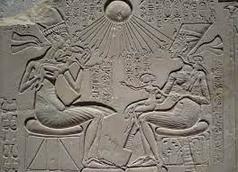
Un intervalo corto del monoteísmo (Atonismo) ocurrió bajo el reinado de Akenatón, enfocado en la deidad egipcia del sol, Atón Akenatón proscribió la veneración de otros dioses y construyó una nueva capital, Aketatón (Amarna), alrededor del templo para Atón.
El cambio religioso perduró solamente hasta la época de Tutankamón, el hijo de Akenatón y de una esposa secundaria Por ser este cambio muy impopular fue rápidamente proscrito De hecho, el borrado de los nombres de Akenatón y Tutankamón de los muros y de las listas reales se relaciona
con este radical cambio religioso
Después de la caída del faraón de Amarna, el panteón egipcio original perduró como fe dominante, hasta la llegada del cristianismo copto y, posteriormente, de la imposición del islam, aunque los egipcios continuaron teniendo relaciones con otras culturas monoteístas, como los hebreos Asombrosamente, el pueblo egipcio apenas opuso resistencia a la difusión del cristianismo, explicado en ocasiones afirmando que Jesús de Nazaret, originalmente, era un sincretismo vinculado principalmente a Horus, con Isis representando a la Virgen María
pirámides: auténticos aparatos o motores astro-espirituales que ayudarían al difunto a convertirse en una estrella eterna del firmamento Con una significado de ser un símbolo de divinidad y eternidad…
Origen en las primeras tumbas de los faraones, que se limitaban a estructuras subterráneas sobre las cuales se hacía edificar una mastaba o pirámide truncada de adobes
Formaba parte de un complejo constituido por un templo y otras edificaciones macizas, alrededor de las cuales se llevaban a cabo diversas celebraciones
Las pirámides de Egipto son un enigma para la sociedad, aunque no siempre estuvieron en el ojo del mundo Son el vivo testimonio de una mentalidad religiosa, pero también de un imperio poderoso y próspero, cuya vocación de poder le permitió sostenerse por más de 3000 años
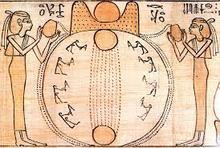
Función última de las
Se trata del primer modelo exitoso de pirámide de caras lisas Estaba destinada a ser la tumba de este faraón. Recibe su nombre por el aspecto actual, ya que ha perdido todo el recubrimiento exterior en piedra caliza blanca.
Conocida también gran pirámide de Guiza se encuentra en la Necrópolis de Guiza Fue construida en la IV dinastía por el arquitecto Hemiunu bajo las órdenes del faraón Keops Se estima que tiene un tiempo desde los 2570 A C
De un complejo funerario, con un lado oriental tiene un templo con este fin así como una calzada procesional hacia el Templo del Valle Da la impresión de ser la más alta debido a su emplazamiento
La pirámide de Snefru se ubica a 40 kilómetros de la ciudad de El Cairo. Se distingue por tener un cambio abrupto de inclinación en la mitad superior de su cuerpo
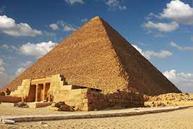
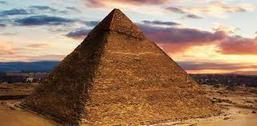
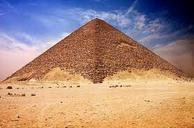

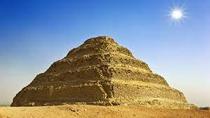
Empezó a construirse con una inclinación de unos 54º , lo que le habría dado una mayor altura A través del tiempo no soportó el peso y se fue inclinando hasta llegar a los 43°
Es la más pequeña de las pirámides de caras lisas que se encuentran en la Necrópolis de Guiza Fue dedicada al Faraón Menkaura de la IV dinastía, hijo de Kefrén y nieto de Keops
As the leaders of the various groups gained and lost influence, the dominant beliefs were transformed, combined, and syncretized Ra and the Aten became the Aten-Ra, with Ra's characteristics as dominant, and later Ra was in turn assimilated by Horus, as Ra-Horajti. After Ptah became Ptah-Seker, he was assimilated by Osiris, becoming Ptah-SekerOsiris The same thing happened with the goddesses: Hathor was initially given the characteristics of other goddesses, but ultimately she was assimilated with Isis. The malefic gods were amalgamated in the same way, under the name Seth, who was originally a hero but later received all the characteristics of the evil gods, in condemnation of being chosen as a patron god by the hated and brutal Hyksos foreign rulers who they seized power for a while

According to the Turin Royal Canon, several gods ruled Egypt: Ptah, Ra, Shu, Geb, Osiris, Seth, Thoth, Maat, and Horus; each for immense periods, then the Shemsu Hor reigned for 13,420 years, before the first dynasty of pharaohs arose Thus Menes's predecessors held the Egyptian throne for 36,620 years
According to the Turin Royal Canon, several gods ruled Egypt: Ptah, Ra, Shu, Geb, Osiris, Seth, Thoth, Maat, and Horus; each for immense periods, then the Shemsu Hor reigned for 13,420 years, before the first dynasty of pharaohs arose Thus Menes's predecessors held the Egyptian throne for 36,620 years

A short interval of monotheism (Atenism) occurred under the reign of Akhenaten, focused on the Egyptian sun deity, Aten Akhenaten outlawed the worship of other gods and built a new capital, Akhetaten (Amarna), around the temple for the Aten The religious change lasted only until the time of Tutankhamen, the son of Akhenaten and a secondary wife As this change was very unpopular it was quickly outlawed In fact, the erasure of the names of Akhenaten and Tutankhamen from the walls and from the royal lists is related

It is the first successful model of a smooth-faced pyramid It was meant to be the tomb of this pharaoh. It gets its name from its current appearance, since it has lost all its white limestone exterior coating
Also known as the Great Pyramid of Giza is located in the Giza Necropolis It was built in the IV Dynasty by the architect Hemiunu under the orders of Pharaoh Cheops It is estimated that it has a time from 2570 BC


with this radical religious change
After the fall of the pharaoh of Amarna, the original Egyptian pantheon endured as the dominant faith, until the arrival of Coptic Christianity and, later, the imposition of Islam, although the Egyptians continued to have relations with other monotheistic cultures, such as the Hebrews Surprisingly, the Egyptian people hardly resisted the spread of Christianity, sometimes explained by stating that Jesus of Nazareth was originally a syncretism linked primarily to Horus, with Isis representing the Virgin Mary
pyramids: authentic astrospiritual devices or motors that would help the deceased to become an eternal star in the firmament With a meaning of being a symbol of divinity and eternity

Origin in the first tombs of the pharaohs, which were limited to underground structures on which a mastaba or truncated adobe pyramid was built.
It was part of a complex made up of a temple and other massive buildings, around which various celebrations were held
The pyramids of Egypt are an enigma for society, although they were not always in the eye of the world They are the living testimony of a religious mentality, but also of a powerful and prosperous empire, whose vocation for power allowed it to sustain itself for more than 3,000 years. last function of
From a funerary complex, with an eastern side it has a temple for this purpose as well as a processional causeway to the Valley Temple. It gives the impression of being the highest due to its location
The Snefru pyramid is located 40 kilometers from the city of Cairo. It is distinguished by having an abrupt change in inclination in the upper half of its body It began to be built with an inclination of about 54º , which would have given it a greater height Over time it could not support the weight and it leaned until it reached 43°

It is the smallest of the smoothsided pyramids found in the Giza Necropolis. It was dedicated to Pharaoh Menkaura of the IV dynasty, son of Kefren and grandson of Cheops
La mitología egipcia se caracteriza por tener una importante iconografía, utilizada para representar a sus deidades con cabezas de animales y cuerpos humanos El desarrollo de tal mitología abarcó un período de miles de años, y a través de ella relacionaban la creación de nuestro mundo, y del de sus dioses
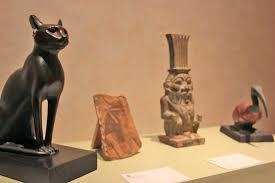


Se originó aproximadamente hace más de 3000 años antes de cristo, y abarcó tres épocas faraónicas denominadas Reino Antiguo, Reino Medio e Imperio Nuevo Los egipcios se caracterizaban por adorar todo lo que implicaba fuerzas naturales
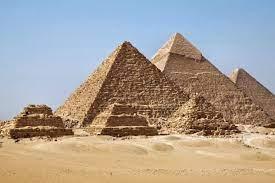
Se los caracteriza por:
Sus creencias se basaban en que existía vida después de la muerte
Eran politeístas, el número de dioses era excesivo, cada uno con determinada representación
Tenían diferentes ritos funerarios
Para ellos el Sol era su Dios supremo Ciertos animales que criaban los consideraban como dioses sagrados
Preservaban el cuerpo después de la muerte, ya que aseguraban que el alma sobreviviría, si esto se hacía
Realizaban la momificación y embalsamiento de los muertos
Cada uno de sus dioses tenían sus respectivos templos
Hacían uso de la iconografía para representar a sus dioses a través de medio torso humano y las cabezas de animales
Egyptian mythology is characterized by having an important iconography, used to represent their deities with animal heads and human bodies The development of such mythology covered a period of thousands of years, and through it they related the creation of our world, and that of their gods. It originated approximately more than 3,000 years before Christ, and spanned three pharaonic epochs called the Old Kingdom, the Middle Kingdom, and the New Kingdom. The Egyptians were characterized by worshiping everything that involved natural forces They are characterized by: Their beliefs were based on the existence of life after death. They were polytheistic, the number of gods was excessive, each one with a certain representation They had different funeral rites For them the Sun was their supreme God Certain animals that they raised considered them to be sacred gods They preserved the body after death, since they ensured that the soul would survive, if this was done They carried out the mummification and embalming of the dead. Each of their gods had their respective temples They made use of iconography to represent their gods through half a human torso and animal heads



